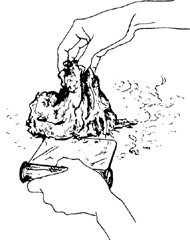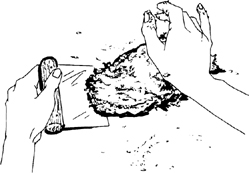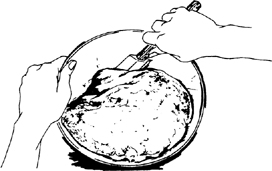Mastering the Art of French Cooking, Volume 2 (26 page)
Read Mastering the Art of French Cooking, Volume 2 Online
Authors: Julia Child

2)
Kneading—pétrissage
The flour will have absorbed the liquid during this short rest, and the dough will have a little more cohesion for the kneading that is about to begin. Use one hand only for kneading and keep the other clean to hold a pastry scraper, to dip out extra flour, to answer the telephone, and so forth. Your object in kneading is to render the dough perfectly smooth and to work it sufficiently so that all the gluten molecules are moistened and joined together into an interlocking web. You cannot see this happen, of course, but you can feel it because the dough will become elastic and will retract into shape when you push it out.
| Start kneading by lifting the near edge of the dough, using a pastry scraper or stiff wide spatula to help you if necessary, and flipping dough over onto itself. |
In 2 to 3 minutes the dough should have enough body so that you can |
|
Shortly after this point, the dough should have developed enough elasticity so that it draws back into shape when pushed, indicating that the gluten molecules have united and are under tension like a thin web of rubber; the dough should also begin to clean itself off the kneading surface, although it will stick to your fingers if you hold a pinch for more than a second or two. Let it rest for 3 to 4 minutes. Knead again for a minute: the surface should now look smooth; the dough will be less sticky but it will still remain soft. It is now ready for its first rise.
3)
First rising—pointage premier temps
(
3 to 5 hours at around 70 degrees
)
You now have approximately 3 cups of dough that is to rise 3½ times its original volume, or to about 10½ cups. Fill the mixing bowl with 10½ cups of tepid water and make a mark to indicate that level on the outside of the bowl (note that the bowl should have fairly upright sides; if they are too outward slanting, the dough will have difficulty rising). Pour out the water, dry the bowl, and place the dough in it; slip bowl into a large plastic bag or cover with plastic, and top with a folded bath towel. Set on a wooden surface (marble or stone are too cold) or on a folded towel or pillow, and let rise free from drafts anyplace where the temperature is around 70 degrees; if the room is too hot, set bowl in water and keep renewing water to maintain it at around 70 degrees. Dough should take at least 3 hours to rise to 10½ cups; if the temperature is lower, it will simply take longer.
(*)
DELAYED ACTION
: See chart at end of recipe.
When fully risen, the dough will be humped into a slight dome, showing that the yeast is still active; it will be light and spongy when pressed. There will usually be some big bubbly blisters on the surface, and if you are using a glass bowl you will see bubbles through the glass.
4)
Deflating and second rising—rupture; pointage deuxième temps
(
1½ to 2 hours at around 70 degrees
)
The dough is now ready to be deflated, which will release the yeast-engendered gases and redistribute the yeast cells so that the dough will rise again and continue the fermentation process.
With a rubber spatula dislodge dough from inside of bowl |
|





